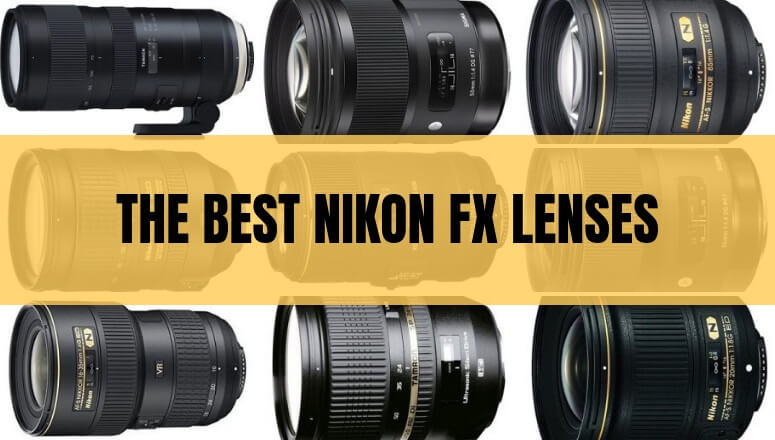Which Nikon FX lens to buy?
If you own a new Nikon SLR with a full-frame sensor (called FX) and are wondering what lens you should get, you’ve come to the right place.
You must have one of the following cameras in your possession: Nikon D610, Nikon D810, Nikon D800, Nikon D850, Nikon D750, Nikon D5.
How this ranking was done: the best Nikon FX lenses in this list were selected according to the following criteria: price, weight, size, and belong to different categories: all-in-one zoom, standard zoom, portrait, street photo, macro, wide angle zoom, wide angle fixed focal length, telephoto zoom…
If you don’t want to read everything, you will find the top 5 of the best Nikon FX lenses at the bottom of the article, as well as a top of the best cheap lenses for Nikon full-format.
Considering the number of Nikon full-size lenses available on the market, this article took me a while to write! Thank you in advance for leaving a comment if there are any corrections to be made.
Note: Product links in this article lead to Amazon.com
Summary
- All-in-one (travel lenses)
- Portraits, reportages and street photography
- Macro
- Wide-angle
- Zoom lens
- Top 5 best Nikon FX lenses
- Comparative table
- Some terms to know
- How to choose your Full Frame FX Nikon lens
- Useful accessories
ALL-IN-ONE (TRAVEL LENSES)
Nikon 28-300mm f/3.5-5.6G ED VR
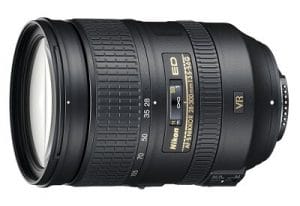
Filter size: 77 mm
Price: Check on Amazon.com
This Nikon 28-300mm is a real Swiss army knife, thanks to its extremely flexible focal length that allows you to switch from a wide angle to zoom. It’s ideal for those who want to travel or go on holiday with only one lens in their bag. Its minimum focusing distance is also sufficient for photo proxy. Focusing is fast, accurate and silent. In good lighting conditions, its vibration reduction system provides excellent image quality. As for its manufacturing quality, it’s a robust lens with a very careful finish. It can be locked to prevent the lens from stretching during transport.
For the disadvantages, it’s rather heavy, and there is a little vignetting and distortion at the end of the race. Too bad also that its focal length does not start at 24mm, which would also allow you to enjoy a practical focal length in landscape photography. Finally, you can’t have everything, and it allows you to do without several objectives.
Click to see the price_
_
Tamron SP 24-70mm f/2.8 Di VC USD
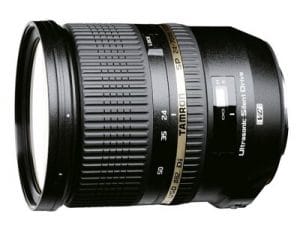
Filter size: 82 mm
Price: Check on Amazon.com
If you are looking for an all-in-one lens that can be used in both wide angle and portrait applications with a large aperture, and that you can take with you when travelling, the Tamron SP 24-70mm f/2.8 offers good performance at an affordable price.
Despite the plastic finish it’s quite solid, the images deliver a very good sharpness, the constant aperture of f/2.8 offers a superb bokeh, and its focus at a short distance (38 cm) offers quite a few possibilities. Finally, the integrated stabilization provides an appreciable comfort of use, and it’s tropicalized.
A very good choice for a very competitive price-quality ratio, even if we can regret its high weight.
Click to see the price_
☛ OTHER OPTIONS
- A G2 version of this Tamron 24-70mm is available for a higher price and makes some improvements. However, some feedback indicates problems with autofocus….
- For smaller budgets and with a similar focal length range, the Nikon AF-S Nikkor 24-85 mm f/3.5-4.5G ED VR offers correct performance at an affordable price and a light weight compared to the other lenses mentioned (it weighs 485g).
- The Nikon AF-S 24-70mm f2.8E ED VR is stabilized and offers a quality of construction and a tropicalization one notch above the Tamron. It’s also more bulky and heavy (1070 g). However, its autofocus system is more efficient than the Tamron in low light. For intensive use it’s therefore to be preferred but its prohibitive price is intended above all for professional photographers.
_
_
PORTRAITS AND STREET PHOTOGRAPHY
Nikon AF-S 85 mm f/1.4G
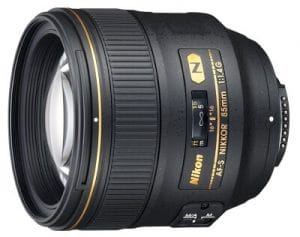
Filter size: 77 mm
Price: Check on Amazon.com
“Magnificent”, “breathtaking”, a “jewel”, these are some of the terms used by many users regarding this 85mm f/1.4, considered as a reference for portrait photography, and this all brands combined.
Its optical quality is impeccable, with superb image sharpness, colour rendering and sublime contrast. It’s also known for its exceptional bokeh that allows you to isolate the subject with an impression of a 3D effect thanks to its 1.4 aperture.
Note that there is no integrated optical stabilization (damage), and it’s tropicalized.
Given the price at which it’s sold, the quality of construction is of course excellent. Its high price makes it accessible only to professionals or amateurs who really want to enjoy themselves but at this price it’s one of the best portrait lenses available on the market.
Click to see the price_
☛ OTHER OPTIONS
- Sigma 85mm f/1.4 DG HSM Art: the excellent Sigma 85mm F1.4 DG HSM Art, more recent, also offers really excellent performance but for a much lower price… and 500g more! Like the Nikon 85mm f/1.4, it’s not stabilized. If weight is not a problem, it’s an alternative to be seriously considered.
- Nikon Nikkor AF-S 85 mm f/1.8G : far from being as good as the Nikon 85mm f/1.4, but it offers satisfactory performance for portraiture at a very affordable price.
_
_
Sigma 50mm f/1.4 DG HSM Art
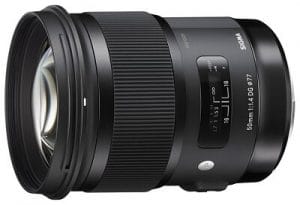
Filter size: 77 mm
Price: Check on Amazon.com
To cover a wide variety of photographic conditions, whether portrait, reportage or even landscape, this Sigma 50mm is a versatile focal lens that delivers a remarkable overall image quality, coupled with excellent construction quality and a sober and discreet design. The very bright maximum aperture of f/1.4 provides a superb background blur. The minimum focusing distance is 40 cm. The HSM motorization allows you to benefit from a particularly discreet, fast and precise focusing.
A few downsides: a rather marked vignetting up to f/2.8, and a lack of homogeneity of the piqué at f/1.4 but beyond that it offers photos of a remarkable sharpness, even on the edges of the image.
It should also be noted that there is no optical stabilization, although the usefulness of such a technology on a standard focal length at f/1.4 is not really useful. It’s a heavy (800g) and not tropicalized camera lens. This may seem like a lot of negative points, but in the fixed focal length category it’s one of the best.
A USB dock is available for updates and to adjust the accuracy of the autofocus.
Click to see the price_
☛ OTHER OPTIONS
- Nikon 50 f1.4G: lighter, more discreet and much cheaper but its autofocus seems to be less efficient than the Sigma and the bokeh, which is a little less pleasant to the eye (question of taste). A very good choice, however, at a reasonable price.
- Nikkor AF-S 50 mm f/1.8G: For those who would like to see what a 50mm on their full size Nikon looks like, the Nikkor AF-S 50mm f/1.8G offers correct performance at a very low price. It’s also a very good lens for light travel.
- Zeiss Otus 55mm f/1.4: If you are a professional and have a big budget to spend on your equipment, the Zeiss Otus 55mm f/1.4 offers extraordinary image quality, but at an exorbitant price (manual focusing).
_
_
Sigma 35mm f/1.4 ART DG HSM
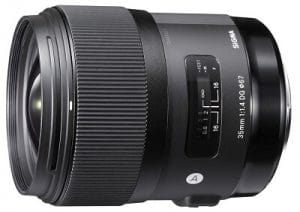
Filter size: 67 mm
Price: Check on Amazon.com
An ideal focal length for street or reportage photography. This Sigma 35mm f/1.4 offers spectacular results, with color rendering, contrast, image clarity and an incredibly beautiful bokeh. All the tests on the net recommend it. The autofocus is silent and its construction quality impeccable.
Be careful, however, some users report a focus problem on some 35mm just unpacked. Sigma sells a USB dock that is used to calibrate the device and make updates from time to time (there seem to be more problems with the D800).
Apart from that it’s an optic that gives a natural angle of view, similar to what the human eye sees and therefore very useful when travelling or even to make portraits, but also photos in difficult light conditions thanks to its f/1.4 aperture. An excellent investment, sold cheaper than its direct competitor the Nikon 35mm f/1.4 (also excellent, rather pro-oriented and tropicalized) and a little more expensive than the Nikon 35mm f/1.8 (the Nikon 35mm 1.8 is also lighter). Given the price difference, you may as well opt directly for the Sigma and shoot at f/1.4.
Click to see the price_
_
MACRO
Sigma 105 mm f/2.8 DG OS HSM
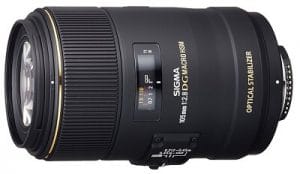
Filter size: 62 mm
Price: Check on Amazon.com
Difficult to choose among the many existing macro lenses, but since you have to select one, the Sigma 105mm f2.8 is very good, its practical focal length to avoid having to stick to the subject, the images delivered have an extra sharpness and offer beautiful background blurred, the autofocus is efficient and fast, and not to spoil anything it’s sold at a correct price and provided with a protective cover. And it has an integrated OS stabilizer that is effective for freehand photography!
A few remarks: it’s quite heavy and the stabilizer emits a slight noise…
In short, overall it’s a very good investment for those who want to have fun photographing small animals or even doing portraits.
Click to see the price_
☛ OTHER OPTIONS
- Tamron sp 90mm f2.8 di macro 1:1 VC USD: also very good, with an exceptional sharpness, but more expensive than the Sigma for similar performance.
- Nikon 105mm f/2.8G Micro VR: is a little old and would need an update to take advantage of modern sensors, but it produces very beautiful images. It’s the most expensive of the three.
_
_
WIDE ANGLE
Nikon 16-35mm f/4G VR
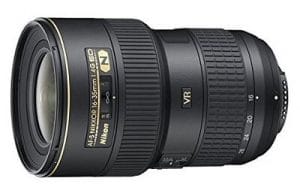
Filter size: 77 mm
Price: Check on Amazon.com
It’s hard to decide between a winner among the different wide angles available for FX sensors, but the Nikon 16-35mm stands out from the crowd because of its weight, optical qualities, versatile focal range and price. It has a constant f/4 aperture and the sharpness is very good at all focal lengths (one of the best at wide-angle at this level).
Its manufacturing quality is good, filters can be screwed in, the autofocus system does the job and it’s equipped with the VR vibration reduction system useful in some cases. There’s some distortion but it’s easy to retouch, in short there’s not much to blame it for.
Click to see the price_
☛ OTHER OPTIONS
If the weight/size are important to you:
- Nikon AF-S NIKKOR 18-35mm f/3.5-4.5G ED: the light weight in the wide angle category (385g), but also one of the cheapest. It offers similar optical performance to the 16-35 but does not have an integrated VR.
If you absolutely need a large aperture:
- Nikon 14-24mm f/2.8G: it’s a little dated (2007), but in terms of image quality and finish it’s (it was?) the best of the best. It has no integrated stabilization, it’s tropicalized, it’s heavy, expensive, and it’s impossible to attach a filter to the glass because the sun visor is integrated into the lens. The 16-35mm seems to be a much better choice unless you really need a constant aperture of f/2.8.
- Tamron SP 15-30 mm f/2.8 Di VC USD: excellent optical quality, a little cheaper than 16-35mm, with a larger aperture, but much heavier (1.1kg), and just like Nikon 14-24mm it’s impossible to screw filters in. It’s up to you!
_
_
Nikon 20 mm f/1.8 AF-S G ED
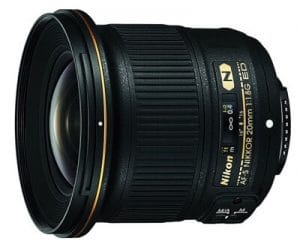
Filter size: 77 mm
Price: Check on Amazon.com
Many options are possible in the category of fixed focal length wide angles, either at Nikon or Sigma. Namely that this type of lens is especially interesting for its high brightness, the ability to make astrophotography and not have to carry a wide-angle zoom that is not very bright and heavy.
The Nikon 20 mm f/1.8 AF-S G ED will therefore be remembered for its weight and compactness (only 355 g), as well as its affordable price compared to other fixed wide angles. In terms of optical performance, it delivers very sharp images even in low light, and the aperture of f/1.8 makes it possible to achieve a superb bokeh. The minimum focusing distance is 20 cm and also makes it possible to make interesting close-ups. No integrated RV, but it’s easy to carry and versatile enough to take you on a trip.
Click to see the price_
_
ZOOM LENS
Tamron SP 70-200mm f/2.8 Di VC USD G2
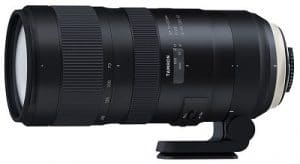
Filter size: 77 mm
Price: Check on Amazon.com
Certainly the best value for money for those looking for a versatile zoom with constant aperture at a reasonable price, this Tamron 70-200mm has nothing to be ashamed of when compared to the best lenses in its class.
It offers several improvements over the previous version: a more modern and elegant all-black aluminum design; a reinforced tropicalization, a minimal focus that increases from 1.3 m to 95 cm, a more responsive and accurate USD autofocus, and an improved VC image stabilizer (especially in performance mode). In terms of image quality, it offers excellent overall performance.
A separately sold USB dock, the Tap-In console, allows you to connect the lens to your PC via USB to update the lens firmware and calibrate the autofocus, stabilization system, and customize different settings if the factory settings do not suit you.
For the weak points of this Tamron: presence of vignetting at f/2.8, with particularly dark corners, a slightly soft dive at f/2.8; its weight of almost 1.5Kg, and a slightly hard and poorly positioned zoom ring.
Click to see the price_
_
Sigma 150-600mm f/5-6.3 DG OS HSM | Contemporary
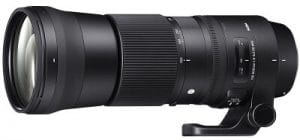
Filter size: 95 mm
Price: Check on Amazon.com
An ideal super zoom for nature or sports photographers, who have received numerous praise in the specialized press and on the web: for just under 1000€ it offers excellent image quality with an impressive level of detail. Its construction quality is excellent, it’s splash and dust resistant and has a front lens with a water and oil repellent treatment. The OS optical stabilization works perfectly and the autofocus is very precise.
Some disadvantages to mention: the weight (nearly 2 kg), and the aperture that requires mounting in ISO. There is also some vignetting on all focal ranges. But these are the compromises to be made to benefit from a super telephoto lens that will not scare the animals! In short, this Sigma 150-600mm is an excellent choice for animal photography.
An optional USB dock is available for updates and to set up autofocus and other settings.
A “sport” version is also available, but its price is more for those who spend a lot of time outdoors: the main differences are in ergonomics but above all in the quality of construction, much more solid and almost waterproof. It also weighs almost 1kg more than the contemporary version! Apart from that, the image quality is the same. A choice to be studied, therefore, according to your needs.
Click to see the price_
☛ OTHER OPTIONS
- Tamron 150-600 mm / F 5.0-6.3 SP DI VC USD G2: it offers similar performances to the Sigma 150-600mm, maybe a little better from 500mm.
- Nikon 200-500mm f/5.6E ED VR: A little heavier than the Sigma C, with a fixed aperture of 5.6 but a slightly shorter focal length and superb manufacturing quality. A very good alternative.
_
_
TOP 5 BEST NIKON FX LENSES
If you have trouble finding your way around, here is a small selection of five Nikon-compatible full-format lenses that you can be sure you won’t go wrong with if you ever hesitate:
- Nikon AF-S 85 mm f/1.4G (THE best of the best Nikon FX lenses for portraits)
- 2. Tamron SP 24-70mm f/2.8 Di VC USD (best nikon travel lens for fx DSLR)
- Nikon 16-35mm f/4G VR (best wide angle lens for nikon fx)
- Sigma 105 mm f/2.8 DG OS HSM (best Nikon FX lens for macro: flowers, insects, coins…)
- Sigma 150-600mm f/5-6.3 DG OS HSM | Contemporary (best Nikon FX lens for wildlife photography)
BEST CHEAP NIKON FX LENSES:
For those with a smaller budget, here’s a list of cheap nikon fx lenses you can start with. They are ranked among the best sellers on Amazon:
Standard lens: The Nikkor AF-S 50 mm f/1.8G, in addition to being cheap, is the lightest of this selection, and ideal for shooting in low light conditions… in short a good lens to get started!
Its older brother the Nikon 50 f/1.4G is a little more expensive, but brighter. It’s therefore a very good option if you absolutely want a 50mm for a reasonable price.
Portrait lens : If you want to make beautiful portraits, the Nikon Nikkor AF-S 85 mm f/1.8G is perfect.
All-in-one lens: To avoid having to take 15 lenses with you, the Nikon AF-S Nikkor 24-85 mm f/3.5-4.5G ED VR is versatile, lightweight and therefore very practical when travelling.
Macro: The Sigma 105 mm f/2.8 DG OS HSM is a great lens to start with macro photography.
Street photography/travel: Finally, the Nikon 35mm f/1.8 is a versatile and bright fixed focal length, quite useful for street photography and every-day use.
_
COMPARATIVE TABLE
All Nikon FX lenses mentioned in this article are collected and classified in this comparative table according to their price, from the cheapest to the most expensive. The list is long but thanks to this table you will be able to see which one will suit you best according to your budget, weight and utility needs.
The prices indicated are those of Amazon at the time of writing. They change regularly, it’s up to you to jump on the right deals!
| Lenses | Price | Weight | Aperture | Filter size | Utility |
|---|---|---|---|---|---|
| Nikkor AF-S 50 mm f/1.8G | $$$$$ | 187g | f/1.8 | 58mm | portrait/street photography |
| Sigma 105 mm f/2,8 DG OS HSM | $$$$$ | 725g | f/2,8 | 62mm | macro |
| Nikon 50 f/1.4G | $$$$$ | 290g | f/1.4 | 58mm | portrait/street photography |
| Nikon AF-S Nikkor 24-85 mm f/3.5-4.5G ED VR | $$$$$ | 485g | f/3.5-4.5 | 72mm | standard zoom |
| Nikon 35mm f/1.8 | $$$$$ | 305g | f/1.8 | 58mm | portrait/street photography |
| Nikon Nikkor AF-S 85 mm f/1.8G | $$$$$ | 350g | f/1.8 | 67mm | portrait |
| Tamron sp 90mm f/2.8 di macro 1:1 VC USD | $$$$$ | 600g | f/2.8 | 62mm | macro |
| Sigma 50mm f/1.4 DG HSM Art | $$$$$ | 820g | f/1.4 | 77mm | portrait/street photography |
| Nikon AF-S NIKKOR 18-35mm f/3.5-4.5G ED | $$$$$ | 385g | f/3.5-4.5 | 77mm | wide angle |
| Sigma 35mm f/1.4 ART DG HSM Nikon | $$$$$ | 670g | f/1.4 | 67mm | portrait/street photography |
| Nikon 35mm f/1.4 | $$$$$ | 670g | f/1.4 | 67mm | portrait/street photography |
| Nikon 20 mm f/1.8 AF-S G ED | $$$$$ | 355g | f/1.8 | 77mm | grand angle à focale fixe |
| Tamron SP 24-70mm f/2.8 Di VC USD | $$$$$ | 825g | f/2.8 | 82mm | standard |
| Nikon 105mm f/2.8G Micro VR | $$$$$ | 790g | f/2.8 | 62mm | macro |
| Nikon 28-300mm f/3.5-5.6G ED VR | $$$$$ | 800 g | f/3.5-5.6 | 77mm | all-in-one |
| Sigma 150-600mm f/5-6.3 DG OS HSM | S contemporary | $$$$$ | 1930g | f/5-6.3 | 95mm | super zoom |
| Sigma 85mm f/1.4 DG HSM Art | $$$$$ | 770g | f/1.4 | 86mm | portrait |
| Tamron SP 15-30 mm f/2.8 Di VC USD | $$$$$ | 1,1kg | f/2.8 | pas de filtre | wide angle |
| Nikon 16-35mm f/4G VR | $$$$$ | 680g | f/4 | 77mm | wide angle |
| Tamron 150-600 mm f/5.0-6.3 SP DI VC USD G2 | $$$$$ | 2,01kg | f/5.0-6.3 | 95mm | super zoom |
| Tamron SP 24-70 mm f/2.8 Di VC USD G2 | $$$$$ | 900g | f/2.8 | 82mm | standard |
| Tamron SP 70-200mm f/2.8 Di VC USD G2 | $$$$$ | 1485g | f/2.8 | 77mm | zoom |
| Nikon 200-500mm f/5.6E ED VR | $$$$$ | 2090g | f/5.6 | 95mm | super zoom |
| Nikon AF-S 85 mm f/1.4G | $$$$$ | 595g | f/1.4 | 77mm | portrait |
| Nikon 14-24mm f/2.8G | $$$$$ | 970g | f/2.8 | pas de filtre | wide angle |
| Nikon AF-S 24-70mm f/2.8E ED VR | $$$$$ | 1,07kg | f/2.8 | 82mm | standard zoom |
| Zeiss Otus 55mm f/1.4 (no auto-focus!) | $$$$$ | 970g | f/1.4 | 77mm | portrait |
_
SOME TERMS TO KNOW
Because it’s not easy to find your way around, here are some abbreviations and terms to know before choosing a new lens for your Nikon full-format SLR:
FX: refers to lenses optimized for Nikon full-format 24x36mm SLR cameras (larger than APS-C sensors). The names of the FX objectives do not include the mention’FX’.
However, FX lenses are compatible with APS-C sensor housings. It’s then necessary to multiply by 1.5 to know the equivalent focal length. For example, the Nikon AF-S 50mm f/1.8G is equivalent to a 75mm focal length when used on an APS-C sensor SLR such as the Nikon D5500.
DX: means that the lens is optimized for APS-C sensor cameras, such as the Nikon D5500, and in general, DX lenses are lighter, more compact and less expensive than FX lenses.
AF-S (AutoFocus SWM): means that the lens is equipped with a SWM (Silent Wave Motor) motor that provides fast, accurate and near-quiet autofocus. Most Nikon lenses now use this technology and therefore most include the AF-S name in their names.
AF-P (AutoFocus Pulse): a new stepping motor technology that is optimized for video: focusing is smooth, smooth and quiet.
G: means that the lens does not have an aperture adjustment ring. The aperture selection is only made from the camera via the body dial. This is the case for most recent objectives.
ED: means that the lens has a lens with a low light dispersion glass type, which corrects chromatic aberrations (defects in the image) and provides better contrast and superior color correction.
VR (Vibration Reduction): means that the lens incorporates an optical image stabilizer that helps to reduce vibration, and thus avoid motion blur when using your handheld SLR.
DG: Sigma’s DG lenses are suitable for both full-format SLR and APS-C cameras.
HSM (Hyper Sonic Motor): a Sigma motorization system that ensures fast and quiet focusing.
OS (Optical Stabilizer): an anti-vibration system from Sigma that reduces camera shake.
EX: the professional range of Sigma lenses, with superior performance in terms of image quality and manufacturing.
Macro: designed for macro photography, i. e. the photography of small subjects (insects, flowers…).
VC (Vibration Compensation): designed by Tamron, the VC image stabilizer allows, as its name suggests, to stabilize the image, and thus to obtain sharp and unblurred images even by hand.
SP (Super Performance): Tamron’s Super Performance Series is a range of premium lenses. Integrated into the SP (Super Performance) lens range, this lens has a high-end manufacturing label dedicated to beauty and performance.
USD (Ultrasonic Silent Drive): Tamron’s autofocus motor technology, which allows fast, accurate and near-quiet focusing.

_
HOW TO CHOOSE YOUR FULL FRAME FX NIKON LENS
Here are some important points to consider before buying a new lens:
The type of photo you want to take: Macro (flowers, insects, small objects…), portraits, wide angle (landscape, architecture)… or simply a versatile lens that will serve you in many types of situations?
Your budget: Unlike traditional APS-C sensor SLRs, FX-format lenses for Nikon full-format SLRs are expensive, if not extremely expensive! This is due to the quality of the glass used, as well as the quality of the building materials used. There are a few exceptions but if you want to invest in good equipment, you will have to break the piggy bank!
Weight and size: if you are looking for lightness and compactness, go on your way! Most lenses for Nikon full format are quite heavy and some can exceed the kilo. Compromises will have to be made.
The aperture: indicated by f/1.8, f/1.4 etc… and indicates the amount of light that enters the lens. To simplify, the smaller this number is, the more you can take pictures in low light (concert, wedding…) and the more beautiful the “bokeh” (or “background blur”) will be!
Nikon, Sigma or Tamron: Even if they are third party manufacturers, Sigma and Tamron offer great lenses, often cheaper than the Nikon equivalent. However, when you read the feedback from users, you realize that there are more problems with the speed and accuracy of autofocus, which require investing in a USB dock to update the lens via your PC, in short, additional costs.
What about buying a DX lens for your full-format camera? a false good idea! Although technically the DX lenses are compatible with Nikon full-format SLRs, they only cover a small part of the large 24×36 sensor. You might as well start on a good foundation and invest directly in an FX objective.
USEFUL ACCESSORIES
A small selection of useful accessories to have in addition to your lenses and your camera (all the links lead to Amazon.com):
You will find detailed technical specifications of Nikon full-size compatible lenses on the Nikon website.
